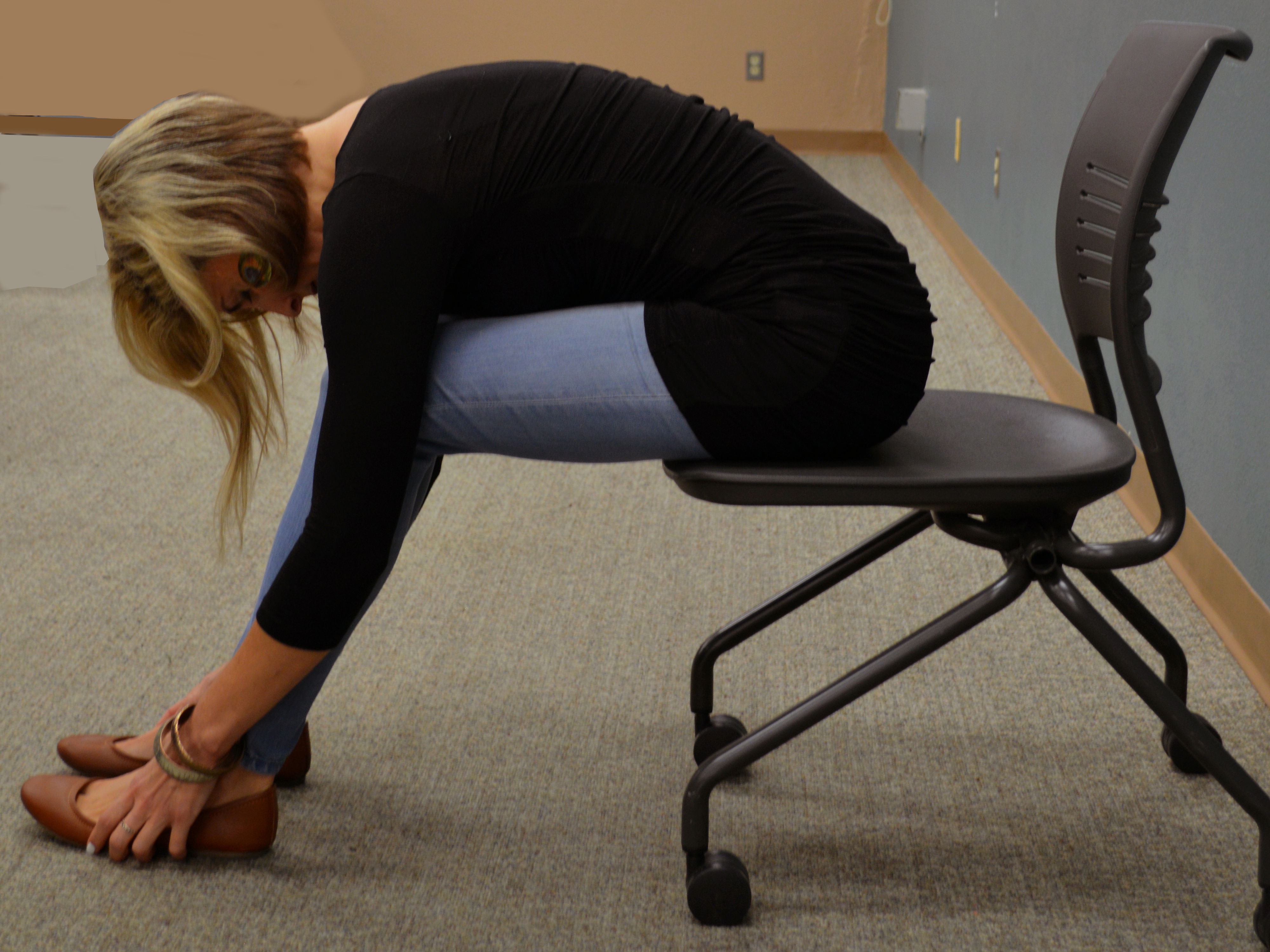Stressed at Work? Time to Stretch it Out!
"We are all probably aware that being sedentary is anathema to good health. High flexors shorten and become chronically tight, as do hamstrings; the lower abdominal muscles lose tone and the low backaches as a result; the neck cranes forward and the upper cervical vertebrae are compressed - tension headache often results. Worse, our breathing becomes shallow and inefficient. And yet, what is a computer-bound person to do? Well, you can start with the following short yoga sequence at your chair and wall! Throughout this sequence, the most important component will be your breath - try to focus more on the sensations of breathing in and out than getting the outer form of the poses exactly "right." With luck, once you return to your work your breathing will remain longer, deeper, and more efficient - and with it your energy and mental clarity improved." -- Leah Stauber, PhD, Clinical Assistant Professor, Nursing
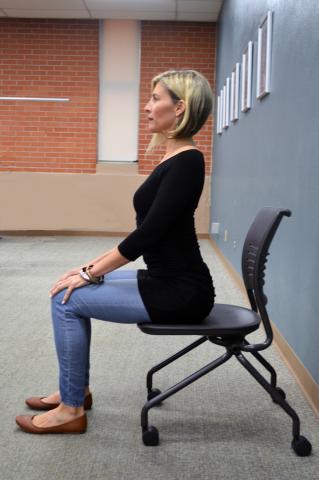
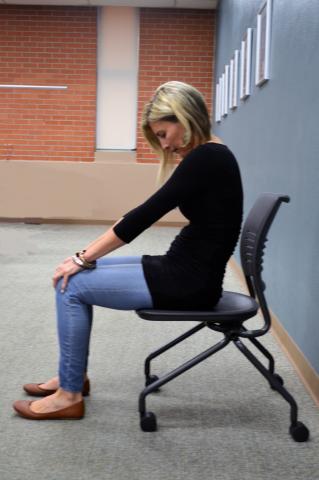
Seated cat-cow pose: Sit on the front edge of a chair, spine long, and place feet about hip-width apart on the floor. Inhaling, rock to the fronts of the sitting bones, expanding chest forward and rolling shoulders down onto the back. Maintain length through the neck and occipital region. Exhaling, draw the belly and chest into the spine, allow the head to drop. Repeat 3-5 times.
This flow helps loosen tight muscles along the spine; particularly relieving tension in the lower back; it helps to re-deepen the breath (sedentary posture is associated with shallow breath) and improve circulation; and it therefore is energizing and supportive of mental focus.
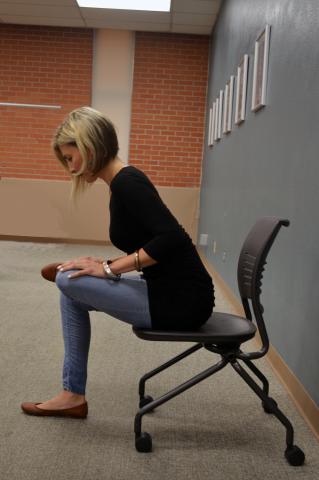
Seated pigeon pose: Sitting on the front edge of a chair, cross one ankle onto the lower thigh (just above the knee) of the opposite leg. Keep the bent-leg foot flexed, with toes pulling back toward bent-leg knee. Lengthen the spine by drawing the low belly inward and upward, inhale, and then with an exhale maintain that spinal length while “folding” forward toward the bent leg. Take 3-5 long rounds of breath, and then slowly lift the torso back up to upright. Repeat on second side.
This pose stretches the IT band and many of the glutes muscles, in turn relieving some lower back discomfort.
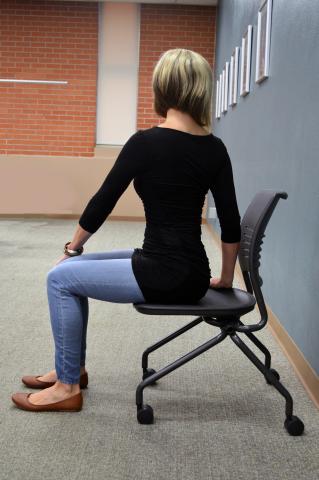
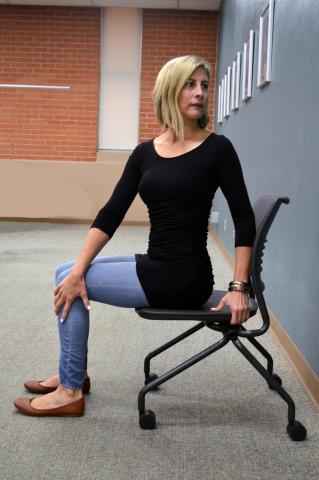
Seated twist: Maintaining the length in the spine that you had when rising up out of the seated forward fold, take a long inhale, and then on the exhale twist to the right, bringing right hand to the wide or back of the chair and pressing the left hand into outer right thigh. Inhale again, and then turn the gaze over the back shoulder. Take 3-5 long rounds of breath. On an exhale, release the twist. Repeat on the second side.
Twisting poses can relieve tightness and discomfort in the lower back, and – when released – are said by traditional yogis to promote the flow of circulation, especially through and around organs, as well as promoting overall spinal health. Go slowly and cautiously into twists, or skip entirely, should you have incipient or evident degeneration in the lumbar spine.
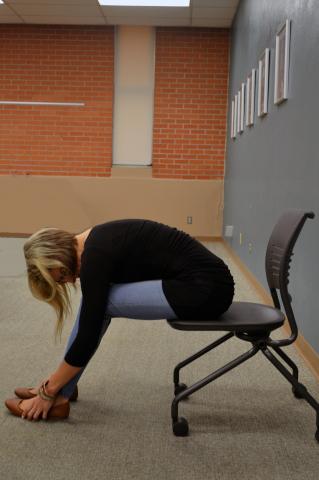
Seated forward fold: Still seated at the front of your chair, with thighs as close to parallel to the floor as possible, place feet hip-width apart on the floor. Lengthen the spine by drawing the low belly inward and upward, inhale, and then with an exhale, maintain that spinal length while folding forward over both legs. At the point at which you feel sufficient stretch through the hamstrings and/or the back of the torso, place the hands wherever is comfortable (lap, lower legs, or floor), relax the head and jaw, and remain for 3-5 long rounds of breath. This pose provides a great opportunity to practice diaphragmatic breathing, by attempting to expand the belly into the resistance of the things on each inhale.
This pose stretches almost the entirety of the “back body,” from hamstrings up through lower and upper spinal regions. Should you wish to stretch the calves as well here, you can pull the toes up off the floor while still folding forward. Traditional yogis say that any kind of “forward-folding” such as this, when the front body moves toward the legs or against the pressure of the floor, has settling and calming properties. We know this to be at least partially supported by the literature of PNS activity.
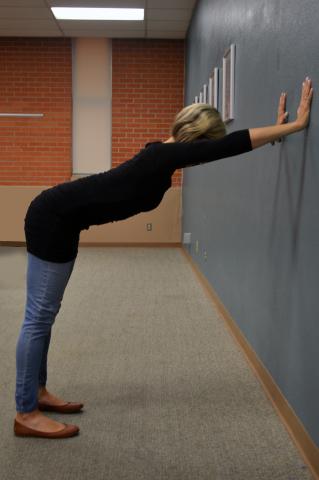
Downward-facing Dog pose at wall: Place hands a few inches lower than your shoulders, and approximately shoulder-width apart, on the wall. Spreading the fingers, focus on pressing the entirety of the hands into the wall, distributing the weight evenly across the palm and all five fingers. Then, walk backward until your spine has lengthened, but is higher than parallel to the floor (see photo). Place feet your own hip-width apart and ground into your heels, keeping the backs of the legs long and straight. Keep pressing the hands into the wall, feeling the chest broaden and the inner shoulder blades draw slightly in toward the upper spine. Keep the head in line with the spine; try to relax the jaw.
Take 3 or more long rounds of breath here, focusing on breathing from the diaphragm into the side ribs and ultimately into the upper back; on the exhales, maintain the effort of lengthening arms and pressing hands into the wall. On completion, slowly walk back in toward the wall, dropping arms to the sides.
This pose stretches the entirety of the back body again, and adds the stretch of various muscle groups through the chest, upper back, arms, and even wrists and hands (these might be particularly tight from computer/ keyboard use). If this pose if painful for the wrists, work the hands up the wall slightly, so that the angle at the back of the wrist is decreased.
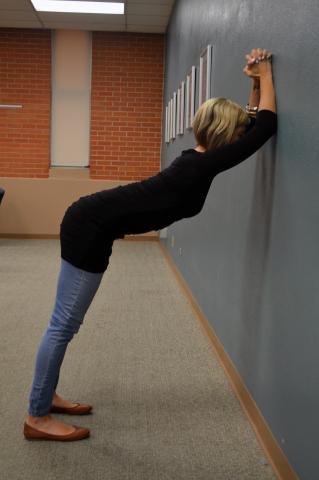
Dolphin pose at the wall: Just as in Downward-facing Dog pose you placed your hands on the wall a few inches lower than your shoulders, and shoulder width apart, you will now place your elbows there. Once the elbows are placed on the wall, you will clasp your hands, with forearms pressing gently but consistently into the wall. Maintaining this, walk backwards until the spine has extended fully. Place your feet at least your own hip width apart, ground into the heels with backs of legs remaining straight, and balance this with the continued pressure of forearms into wall.
Take 3 or more long rounds of breath here, focusing on breathing from the diaphragm into the side ribs and ultimately into the upper back; on the exhales, maintain the effort of lengthening spine and pressing forearms into the wall. On completion, slowly walk back in toward the wall, dropping arms to the sides.
This pose, like Downward-facing Dog at the wall, stretches the entirety of the back body, adding in a bit of extra intensity to the upper back and shoulder region. Both poses, combined with conscious, diaphragmatic breathing, may improve circulation to the neck and head, providing an energizing and mentally clarifying effect.


